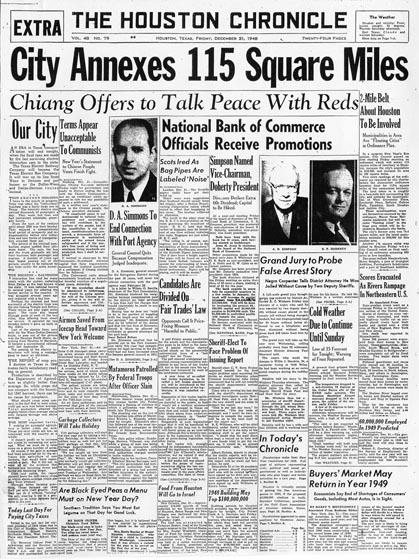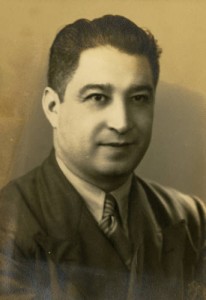
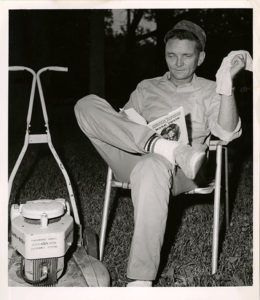
Photograph of Leon Hale via the Leon Hale Papers, University of Houston Special Collections.
In a journalistic career that has spanned over 65 years, with a daily column at the Houston Post that ran from 1948-1984 and the Houston Chronicle from 1984-2014, Leon Hale has literally written about the who, what, when, where, and why that so many journalists attempt to capture. His folksy, plain, straightforward style of writing, as he eschewed fancy complex words, elevated the ordinary musings and experiences into the extraordinary which would have his readers laugh out loud or cry, sometimes both, and in the process take his readers along on his adventures to small towns and locales all across Texas and beyond.
Nothing was too mundane or ordinary to write about, whether it was his personal experience of trusting and biting into a jalapeño pepper at a roadside store near Somerville and then describing its agonizing effects in detail, to the little things we all notice when the power goes out–the quiet, the darkness, neighbors congregating outside, and especially no A/C in the summer.
It’s these little slices of humanity and the interesting cast of characters that he has come across along life’s journey as a reporter that has endeared him to many of his faithful readers along the way for so many years. He’s touched many lives as the history of families and the places he has visited are captured in his daily columns with the Houston Post.
The Leon Hale Papers are part of the Houston & Texas History Research Collection at the University of Houston Special Collections.
Whether it’s a rare book printing found at long last or piece of ephemera found in an archival collection by chance, those who visit the University of Houston Special Collections almost always find something they cannot wait to share with others. Here we celebrate what makes the University of Houston Special Collections so special–our Favorite Things.
The satellite view is spectacular and confirms what we already know—Houston is big. At last count, Houston’s incorporated area covers about 667 square miles. We know this because the City of Houston Planning & Development Department has created an informative slide show that illustrates the city’s ever-changing boundaries. “Annexations in Houston or How we grew to 667 square miles in 175 years” can be found online.
If you want to research urban planning in Houston the old-fashioned way—using text and images printed on paper—try the Special Collections Department at UH Libraries. I recommend the old-fashioned way because, while it is not as convenient as surfing the web, it is way more fun.
Discoveries abound in Special Collections. Every folder holds a surprise. My most recent discovery was a set of maps from the Paddock Greater Houston Convention & Visitors Council Records. As the name suggests, this collection contains records collected by Marianita Paddock from her years with the Greater Houston Convention & Visitors Council. But it also includes maps of cities and counties in Texas from the mid-twentieth century. Some of the maps are common but others are unusual, such as a 1948 Ashburn’s Map of Houston in a special edition issued for Forest Park cemetery on Lawndale.
The most significant is the City of Houston’s Zoning District Map, December 15, 1947. Houston was small once, and I don’t mean when the Allen Brothers founded it in 1836. As late as the 1940s, it was a compact city of 75 square miles. This map reminds us that in 1947 the city’s boundaries extended no farther than Kirby Drive on the west, Brays Bayou on the southwest, and Sims Bayou on the southeast. The Heights, Rice Institute, and the new Texas Medical Center were on the edge of town.
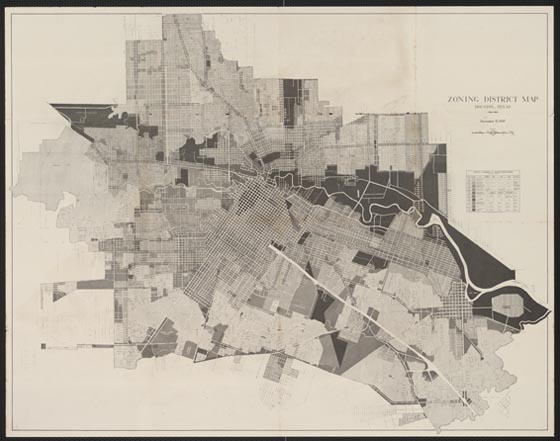
City of Houston, Zoning District Map, December 15, 1947, Paddock Greater Houston Convention & Visitors Council Records
The map is a historical footnote to the larger question of urban planning in Houston. Most people know that Houston is the largest city in the country without land use zoning. So why was the city publishing a zoning map? The answer is that it was done to educate citizens about the issues in the upcoming special election in January 1948 when they would be asked to approve a new law authorizing zoning. It’s no spoiler to say that voters rejected the law. Progressives in Houston are gluttons for punishment and tried again in 1962 and 1993. Voters were unmoved and we still have no zoning.
More importantly, the map is a detailed snapshot of the city’s boundaries, street system, and land uses on the eve of its great suburbanization. On December 31, 1948, only a year after the map was published, the city council approved an ordinance annexing a large swath of territory that more than doubled the city’s land area to 189 square miles. Houston was small no more. This was the first of many annexations, done to preserve the city’s tax base and its ability to grow.
City council waited until New Year’s Eve to drop this bombshell. The Houston Chronicle responded with a banner headline. Pasadena and other neighboring cities were not thrilled by the news. Their New Year’s hangover was beginning early and would continue for decades more.
In August 2013 I was extremely excited to begin my position as the Houston Arts and History Archives Fellow at the University of Houston Libraries Special Collections. I was straight out of my graduate program at the University of Michigan and ready to dive into the field as a professional archivist. I was also thrilled to return to Houston, my hometown and favorite city, and to work with materials that reflected the community where I grew up. Over the following two years, I worked on some amazing projects, developed inspiring working relationships, and gained knowledge and skills that I’ll use throughout my career.
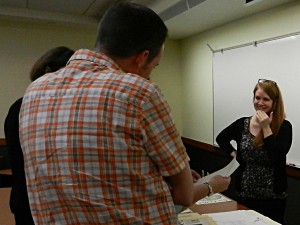
Houston Arts and History Archives Fellow, Stacey Lavender (far right), showcases items from the Main Street Theater Records.
The two largest portions of my time here at UH have been dedicated to arranging and describing archival collections and to assisting with the curation of digital projects. I have worked with a wide variety of materials in our Houston Hip Hop, Houston and Texas History, Performing and Visual Arts, and Contemporary Literature collections. I’ll admit that when I started, I was most excited to work with Houston hip hop materials. I felt that hip hop materials were in particularly great need of collecting and that they would resonate particularly strongly with students. I was right! But at the same time, I discovered that each of the collections I worked with, whether they included materials from a German singing club with over 100 years of history, one of the largest regional theatres in the nation, or 1970s and 1980s science fiction and fantasy conventions, documented an important part of our history and held direction connections to the Houston community. I’m proud to have contributed to making so many new materials accessible to our students and researchers, and working with such a diverse array of materials certainly kept me on my toes and made coming to work every day exciting!
I’m grateful that this position also provided many opportunities to work directly with our patrons. Throughout my time at UH I spent about eight hours a week manning the reference desk, and this January I also began serving as contact point for Performing and Visual Arts reference. It’s always my pleasure to help students and researchers find the materials they need. One of the most exciting (and unexpected!) outreach projects I worked on was co-curating the “Nina Vance and the Alley Theatre: A Life’s Work” exhibit with our Architecture & Art Library Coordinator Catherine Essinger. Designing and implementing the exhibit, which ran from October, 2014 to May, 2015, gave me the opportunity to work with people all over the library, across campus, and with former and current Alley Theatre actors and staff. I’ll always remember it as one of my favorite accomplishments here.
UH has also been very supportive of my professional development, which I think is essential for any early-career librarian or archivist. I have attended several conferences and workshops during my time here, and completed my first professional presentation at the Society of Southwest Archivists convention in 2014.
But perhaps my favorite thing about working at the University of Houston Special Collections was the opportunity to work with such an amazing group of colleagues, both in our department and across the library. I’ll miss coming to work with them every day, but I look forward to our paths crossing in the future as I continue my archives career.
The following piece appears courtesy of Dan Johnson, 2013 Mosaic Fellow, wherein he provides a look at a sampling of projects benefiting from his internship with the University of Houston Special Collections.
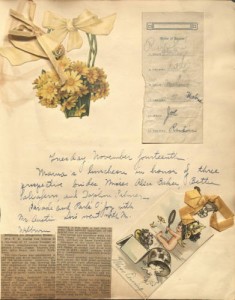
A full dance card (Gladys Ewing’s 1911 Houston Society Scrapbook, The Ewing Family Papers)
I was selected as a Mosaic Fellow in the Fall of 2013 by the Association of Research Libraries and the Society of American Archivists. I’m presently a MSLS student at the University of North Texas, studying Archival Studies and Digital Image Management. The Mosaic Fellowship included an internship component, pairing up fellows with host ARL institutions; I was glad to have the opportunity to intern here at UH Special Collections since September 2014. I’ve since had the pleasure of working on a variety of special projects, working hands on with archival materials.
I first started a digital audit of the Ewing Family Papers, comparing the physical archival collection to its finding aid and existing digital collection. In that review of the Ewing family scrapbooks, I worked with Valerie Prilop, Digital Collections Librarian, and we discovered that the finding aid for one of the scrapbooks provided descriptions for only the front side of each scrapbook page, but did not describe the reverse side, while the digital collection had page-level descriptions for both front and back sides of the pages. Ultimately, we were able to identify places where the finding aid could be improved, and we made some recommendations to combine two digital collections, one per scrapbook, into a single consolidated digital collection, a project for a later date.
I then started a project under the guidance of University Archivist Mary Manning, processing and describing additions to the William C. Moffit Papers. The collection was originally donated by Dr. Moffit himself, but several additions were later donated by his wife and family after he passed away. I was able to process and describe some additional manuscript parts, published musical arrangements, and Patterns of Motion training materials, among other things. Working with a member of the faculty from the School of Music who was intimately familiar with Dr. Moffit’s work helped me better describe and arrange the materials in a way that will make the most sense to researchers using this collection.
I started work on a third project with Hispanic Collections Archivist Lisa Cruces, auditing the physical material of the Alonso S. Perales Papers and comparing the physical archival collection to the finding aid. There were a handful of items in the physical collection that were not reflected in the finding aid, and I have been correcting the finding aid to more faithfully represent the collection.
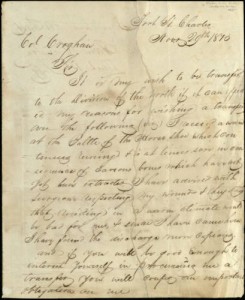
Request for transfer to a unit in the north signed by Sam Houston (November 29, 1813, Early Texas Documents Collection)
Most recently, I’ve been given the opportunity to work with Librarian Emerita Pat Bozeman on a project transcribing and contextualizing some handwritten letters. Two of these items were taken from the Early Texas Documents collection. One item is a letter from Sam Houston written after he was wounded in the Battle of Horseshoe Bend. It documents his request to be transferred from New Orleans to a more northern location upon the advice of several physicians. Another item is a letter that highlights Stephen F. Austin’s efforts to gather support from the United States government and people for Texas Independence and was written in Nashville, Tennessee days before Texas declared independence from Mexico. Working intimately with historical documents such as these has been a very exciting and rewarding experience.
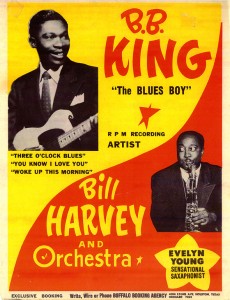
promotional poster for B.B. King and Bill Harvey & Orchestra (Texas Music Collection)
Today marks the last day of visitation before the King of Blues is laid to his final rest at the B.B. King Museum and Delta Interpretive Center. On hearing the news of this music legend’s passing nearly two weeks ago, one could not help but pause and reflect on his storied career that made him synonymous with the blues and even extended his broad cultural imprint beyond music. Here at the University of Houston Special Collections, Houston and Texas History Archivist Vince Lee shared some of his ongoing work as part of a digitization project and its surprising connection to B.B. King.
The Texas Music Collection contains research files on the history of Texas music, with an emphasis on the musicians and record labels of the mid-twentieth century. There among the newspaper clippings, songbooks, and financial records, Lee points out, are promotional photographs of some of the most renowned musicians to call Houston home–including the late B.B. King.
King’s brand of the blues may always be associated with Beale Street and his deep Memphis roots, but the reasons why his photograph might show up in an archival box in Houston are likely less well-known. A recent piece in the Houston Press by Chris Gray is an excellent primer on the King-Houston connection and references the research of Dr. Roger Wood (author of Down In Houston: Bayou City Blues) on the role music business mogul Don Robey played in King’s connection to Houston.
Founder of Peacock Records, the Houston native Robey acquired Duke Records (previously based in Memphis) with the same business aplomb that marked his other interests and acquisitions, giving him easy access to a roster of talented Memphis-based musicians and industry connections. Among those connections was a young B.B. King. Though King never signed with Duke/Peacock, it was natural that the Houston-based Buffalo Booking Agency representing B.B. King (also owned by Robey) would help stock his touring band with musicians from Robey’s many record labels and with plenty of what Wood calls that “Texas tenor, big-band sound.” These tours, Wood argues, maximized B.B. King’s exposure to audiences and were critical in his professional success.
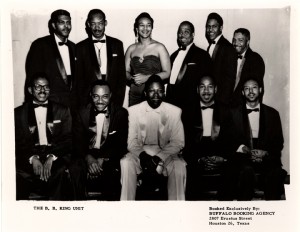
promotional photograph for the B.B. King Unit (Texas Music Collection)
Materials from the Duke/Peacock label feature prominently in the Texas Music Collection and promotional photographs from the Buffalo Booking Agency are not hard to find. One promotional photograph for the B.B. King Unit features a very young-looking luminary flanked by his band, including vocalist Mildred Jones (booked exclusively by Buffalo Booking, Houston, TX, the fine print reminds us).
These promotional photographs, that also include other greats like Junior Parker, “Gatemouth” Brown, and Johnny Ace, are another example of the surprises found in the archives on a daily basis. As we remember B.B. King, we are also thankful to have these reminders of his career and legacy. Interested researchers may request the Texas Music Collection in the Special Collections Reading Room during our normal hours of operation.

